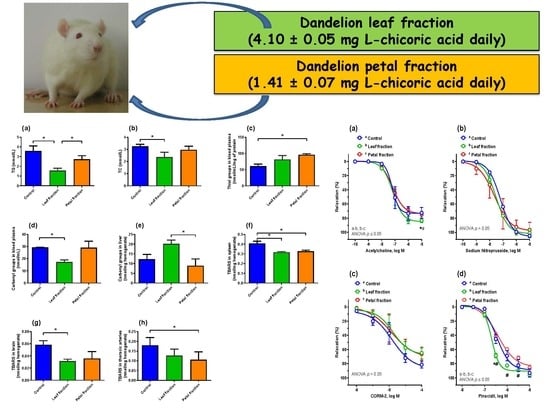Phenolic Fractions from Dandelion Leaves and Petals as Modulators of the Antioxidant Status and Lipid Profile in an In Vivo Study
Abstract
1. Introduction
2. Materials and Methods
2.1. Plant Material
Extraction and Preparation of Dandelion Phenolic Fractions
2.2. Drugs and Chemicals
2.3. Ethics Statements
2.4. Animal Protocol and Dietary Treatment
2.5. Experimental Procedures
2.5.1. Blood Plasma Glucose and Lipid Profile
2.5.2. ORAC, TBARS, Thiol and Carbonyl Groups
2.5.3. The Intestinal Digesta
2.5.4. Urine F2α-Isoprostane
2.5.5. Blood Pressure and Heart Rate in Rats
2.5.6. Vascular Reactivity Studies
2.6. Data Analysis and Statistics
3. Results
3.1. The Phytochemical Characteristics of Dandelion Leaf and Petal Fractions
3.2. General Characterization of Rats
3.3. The Intestinal Digesta
3.4. Blood Pressure and Heart Rate in Rats
3.5. Blood Plasma Glucose and Lipid Profile
3.6. The Antioxidant Status
3.7. Urine F2α-Isoprostane
3.8. Vascular Reactivity Studies
4. Discussion
5. Conclusions
Supplementary Materials
Author Contributions
Funding
Conflicts of Interest
References
- Cruz, A.B.; Pitz, H.D.; Veber, B.; Bini, L.A.; Maraschin, M.; Zeni, A.L. Assessment of bioactive metabolites and hypolipidemic effect of polyphenolic-rich red cabbage extract. Pharm. Biol. 2016, 54, 3033–3039. [Google Scholar] [CrossRef] [PubMed]
- Olas, B.; Kontek, B.; Szczesna, M.; Grabarczyk, L.; Stochmal, A.; Zuchowski, J. Inhibition of blood platelet adhesion by phenolics’ rich fraction of Hippophae rhamnoides L. fruits. J. Physiol. Pharmacol. 2017, 68, 223–229. [Google Scholar] [PubMed]
- Lis, B.; Jędrejek, D.; Stochmal, A.; Olas, B. Assessment of effects of phenolic fractions from leaves and petals of dandelion in selected components of hemostasis. Food Res. Int. 2018, 107, 605–612. [Google Scholar] [CrossRef] [PubMed]
- Zingue, S.; do Carmo, Í.A.R.; Tchoumtchoua, J.; Tchoupang, E.N.; Bratti, L.O.S.; Mora, T.D.; Halabalaki, M.; Njamen, D.; Creczynski-Pasa, T.B.; Filippin-Monteiro, F.B. Millettia macrophylla (Fabaceae) phenolic fraction prevents differentiation of 3T3-L1 adipocytes and the increased risks of cardiovascular diseases in ovariectomized rats. J. Ethnopharmacol. 2018, 222, 87–98. [Google Scholar] [CrossRef]
- Majewski, M.; Ognik, K.; Juśkiewicz, J. The interaction between resveratrol and two forms of copper as carbonate and nanoparticles on antioxidant mechanisms and vascular function in Wistar rats. Pharmacol. Rep. 2019, 71, 862–869. [Google Scholar] [CrossRef]
- Majewski, M.; Ognik, K.; Juśkiewicz, J. The antioxidant status, lipid profile, and modulation of vascular function by fish oil supplementation in nano-copper and copper carbonate fed Wistar rats. J. Funct. Foods 2020, 64, 103595. [Google Scholar] [CrossRef]
- Majewski, M.; Ognik, K.; Thoene, M.; Rawicka, A.; Juśkiewicz, J. Resveratrol modulates the blood plasma levels of Cu and Zn, the antioxidant status and the vascular response of thoracic arteries in copper deficient Wistar rats. Toxicol. Appl. Pharmacol. 2020. [Google Scholar] [CrossRef]
- Qureshi, S.; Adil, S.; Abd El-Hack, M.E.; Alagawany, M.; Farag, M.R. Beneficial uses of dandelion herb (Taraxacum officinale) in poultry nutrition. Worlds Poult. Sci. J. 2017, 73, 591–602. [Google Scholar] [CrossRef]
- Saeed, M.; Abd El-Hack, M.E.; Alagawany, M.; Arain, M.A.; Arif, M.; Mirza, M.A.; Naveed, M.; Chao, S.; Sarwar, M.; Sayab, M.; et al. Chicory (Cichorium intybus) herb: Chemical composition, pharmacology, nutritional and healthical applications. Int. J. Pharmacol. 2017, 13, 351–360. [Google Scholar] [CrossRef]
- Martinez, M.; Poirrier, P.; Chamy, R.; Prufer, D.; Schulze-Gronover, C.; Jorquera, L.; Ruiz, G. Taraxacum officinale and related species—An ethnopharmacological review and its potential as a commercial medicinal plant. J. Ethnopharmacol. 2015, 169, 244–262. [Google Scholar] [CrossRef]
- Zhao, J.; Zhang, G.; Zhou, X.; Dong, W.; Wang, Q.; Xiao, C.; Zhang, S. Effect of Dandelion root extract on growth performance, immune function and bacterial community in weaned pigs. Food Agric. Immunol. 2019, 30, 95–111. [Google Scholar] [CrossRef]
- Hu, G.; Wang, J.; Hong, D.; Zhang, T.; Duan, H.; Mu, X.; Yang, Z. Effects of aqueous extracts of Taraxacum officinale on expression of tumor necrosis factor-alpha and intracellular adhesion molecule 1 in LPS-stimulated RMMVECs. BMC Complement. Altern. Med. 2017, 17, 38. [Google Scholar] [CrossRef] [PubMed]
- Jeon, D.; Kim, S.J.; Kim, H.S. Anti-inflammatory evaluation of the methanolic extract of Taraxacum officinale in LPS-stimulated human umbilical vein endothelial cells. BMC Complement. Altern. Med. 2017, 17, 508. [Google Scholar] [CrossRef] [PubMed]
- Liu, B.; He, Z.; Wang, J.; Xin, Z.; Wang, J.; Li, F.; Fu, Y. Taraxasterol inhibits LPS-induced inflammatory response in BV2 microglia cells by activating LXRα. Front. Pharmacol. 2018, 9, 278. [Google Scholar] [CrossRef] [PubMed]
- Koh, Y.J.; Cha, D.S.; Ko, J.S.; Park, H.J.; Choi, H.D. Anti-inflammatory effect of Taraxacum officinale leaves on lipopolysaccharide-induced inflammatory responses in RAW 264.7 cells. J. Med. Food 2010, 13, 870–878. [Google Scholar] [CrossRef] [PubMed]
- Hu, C.; Kitts, D.D. Dandelion (Taraxacum officinale) flower extract suppresses both reactive oxygen species and nitric oxide and prevents lipid oxidation in vitro. Phytomedicine 2005, 12, 588–597. [Google Scholar] [CrossRef]
- Hu, C.; Kitts, D.D. Luteolin and luteolin-7-O-glucoside from dandelion flower suppress iNOS and COX-2 in RAW264.7 cells. Mol. Cell. Biochem. 2004, 265, 107–113. [Google Scholar] [CrossRef]
- Tsai, K.L.; Kao, C.L.; Hung, C.H.; Cheng, Y.H.; Lin, H.C.; Chu, P.M. Chicoric acid is a potent anti-atherosclerotic ingredient by anti-oxidant action and anti-inflammation capacity. Oncotarget 2017, 8, 29600–29612. [Google Scholar] [CrossRef]
- Williams, C.A.; Goldstone, F.; Greenham, J. Flavonoids cinnamic acids and coumarins from the different tissues and medicinal preparations of Taraxacum officinale. Phytochemistry 1996, 42, 121–127. [Google Scholar] [CrossRef]
- Schütz, K.; Kammerer, D.R.; Carle, R.; Schieber, A. Characterization of phenolic acids and flavonoids in dandelion (Taraxacum officinale WEB. Ex WIGG) root and herb by high-performance liquid chromatography/electrospray ionization mass spectrometry. Rapid Commun. Mass Spectrom. 2005, 19, 179–186. [Google Scholar] [CrossRef]
- Jędrejek, D.; Kontek, B.; Lis, B.; Stochmal, A.; Olas, B. Evaluation of antioxidant activity of phenolic fractions from the leaves and petals of dandelion in human plasma treated with H2O2 and H2O2/Fe. Chem. Biol. Interact. 2017, 262, 29–37. [Google Scholar] [CrossRef] [PubMed]
- Choi, U.K.; Lee, O.H.; Yim, J.H.; Cho, C.W.; Rhee, Y.K.; Lim, S.I.; Kim, Y.C. Hypolipidemic and antioxidant effects of dandelion (Taraxacum officinale) root and leaf on cholesterol-fed rabbits. Int. J. Mol. Sci. 2010, 11, 67. [Google Scholar] [CrossRef]
- Kenny, O.; Smyth, T.J.; Hewage, C.M.; Brunton, N.P. Antioxidant properties and quantitative UPLC-MS/MS analysis of phenolic compounds in dandelion (Taraxacum officinale) root extracts. Free Radic. Antioxid. 2014, 4, 55–61. [Google Scholar] [CrossRef]
- Mollace, V.; Muscoli, C.; Masini, E.; Cuzzocrea, S.; Salvemini, D. Modulation of prostaglandin biosynthesis by nitric oxide and nitric oxide donors. Pharmacol. Rev. 2005, 57, 217–252. [Google Scholar] [CrossRef] [PubMed]
- Dávalos, A.; Gómez-Cordovés, C.; Bartolomé, B. Extending applicability of the oxygen radical absorbance capacity (ORAC-fluorescein) assay. J. Agric. Food Chem. 2004, 52, 48–54. [Google Scholar] [CrossRef]
- Levine, R.L.; Garland, D.; Oliver, C.N.; Amici, A.; Climent, I.; Lenz, A.G.; Ahn, B.W.; Shaltiel, S.; Stadtman, E.R. Determination of carbonyl content in oxidatively modified proteins. Methods Enzymol. 1990, 186, 464–478. [Google Scholar]
- Bradford, M. A rapid and sensitive method for the quantitation of microgram quantities of protein utilizing the principle of protein-dye binding. Anal. Biochem. 1976, 72, 248–254. [Google Scholar] [CrossRef]
- Gargouri, M.; Magné, C.; Ben Amara, I.; Ben Saad, H.; El Feki, A. Dandelion-enriched diet of mothers alleviates lead-induced damages in liver of newborn rats. Cell. Mol. Biol. 2017, 63, 67–75. [Google Scholar] [CrossRef]
- Gulfraz, M.; Ahamd, D.; Ahmad, M.S.; Qureshi, R.; Mahmood, R.T.; Jabeen, N.; Abbasi, K.S. Effect of leaf extracts of Taraxacum officinale on CCl4 induced hepatotoxicity in rats, in vivo study. Pak. J. Pharm. Sci. 2014, 27, 825–829. [Google Scholar]
- Arafa, R.M.; Massoudel-Said, M.; Abdel-Rahman, M.K.; Abdel-Megeid, A.A. Carbon tetrachloride—Induce hepatotoxicity in rats: The potential effect of bread supplemented with dandelion (Taraxacum officinale) on the nutritional status. Agricultura 2010, 7, 23–32. [Google Scholar]
- Kim, J.J.; Park, C.M.; Kim, M.J.; Cho, C.W.; Song, Y.S. Hypolipidemic effect of dandelion (Taraxacum officinale) extracts via fecal lipid excretion in C57BL/6 mice fed an atherogenic diet. Food Sci. Biotechnol. 2014, 23, 841–847. [Google Scholar] [CrossRef]
- Cho, S.Y.; Park, J.Y.; Park, E.M.; Choi, M.S.; Lee, M.K.; Jeon, S.M.; Jang, M.K.; Kim, M.J.; Park, Y.B. Alternation of hepatic antioxidant enzyme activities and lipid profile in streptozotocin-induced diabetic rats by supplementation of dandelion water extract. Clin. Chim. Acta 2002, 317, 109–117. [Google Scholar] [CrossRef]
- Karakuş, A.; Değer, Y.; Yıldırım, S. Protective effect of Silybum marianum and Taraxacum officinale extracts against oxidative kidney injuries induced by carbon tetrachloride in rats. Ren. Fail. 2017, 39, 1–6. [Google Scholar] [CrossRef] [PubMed]
- Jia, L.; Chen, Y.; Tian, Y.H.; Zhang, G. MAPK pathway mediates the anti-oxidative effect of chicoric acid against cerebral ischemia-reperfusion injury in vivo. Exp. Ther. Med. 2018, 15, 1640–1646. [Google Scholar] [CrossRef]
- Vilahur, G.; Padró, T.; Casaní, L.; Mendieta, G.; López, J.A.; Streitenberger, S.; Badimon, L. Polyphenol-enriched diet prevents coronary endothelial dysfunction by activating the Akt/eNOS pathway. Revista Española de Cardiología (Engl. Ed.) 2015, 68, 216–225. [Google Scholar] [CrossRef]
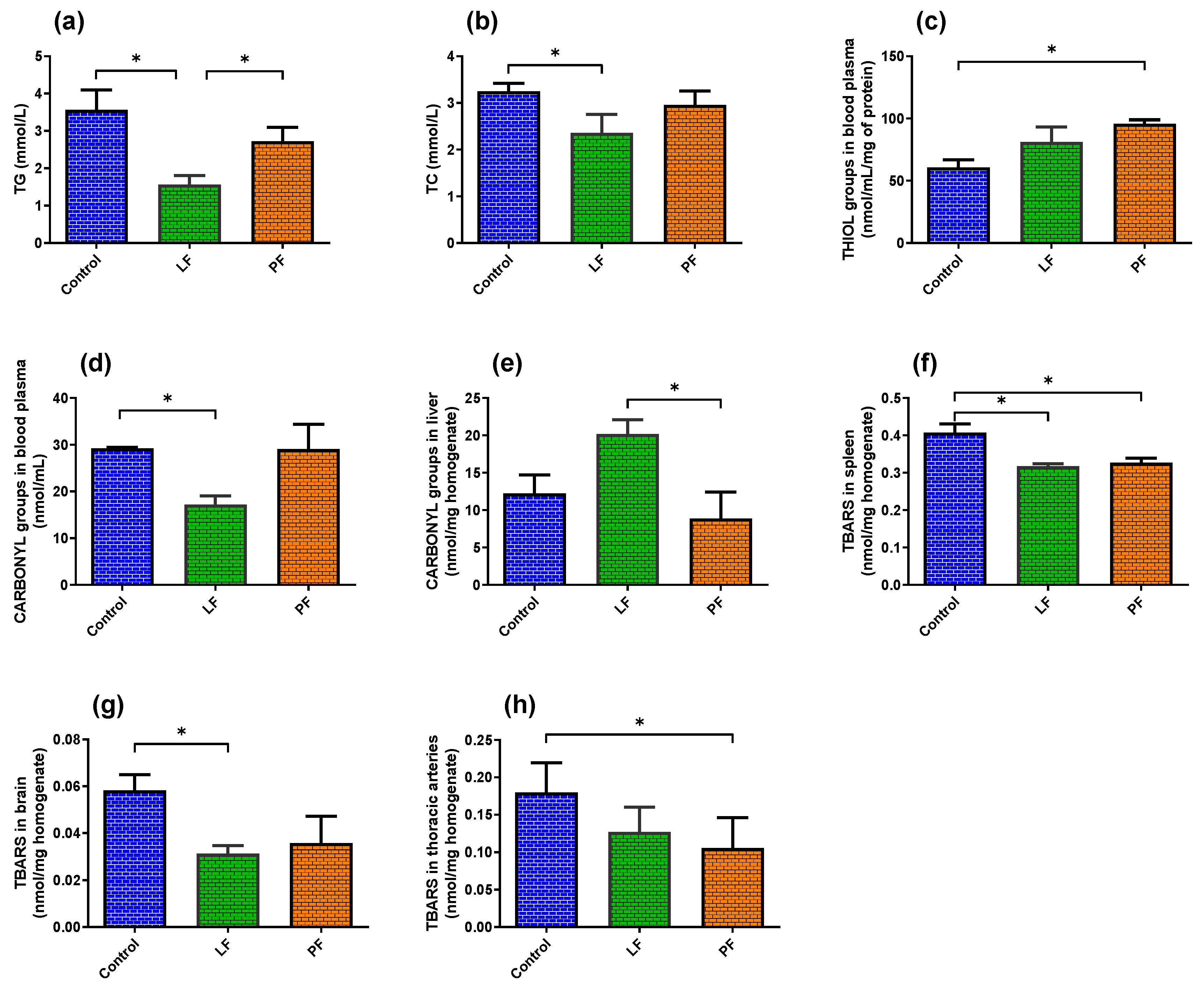
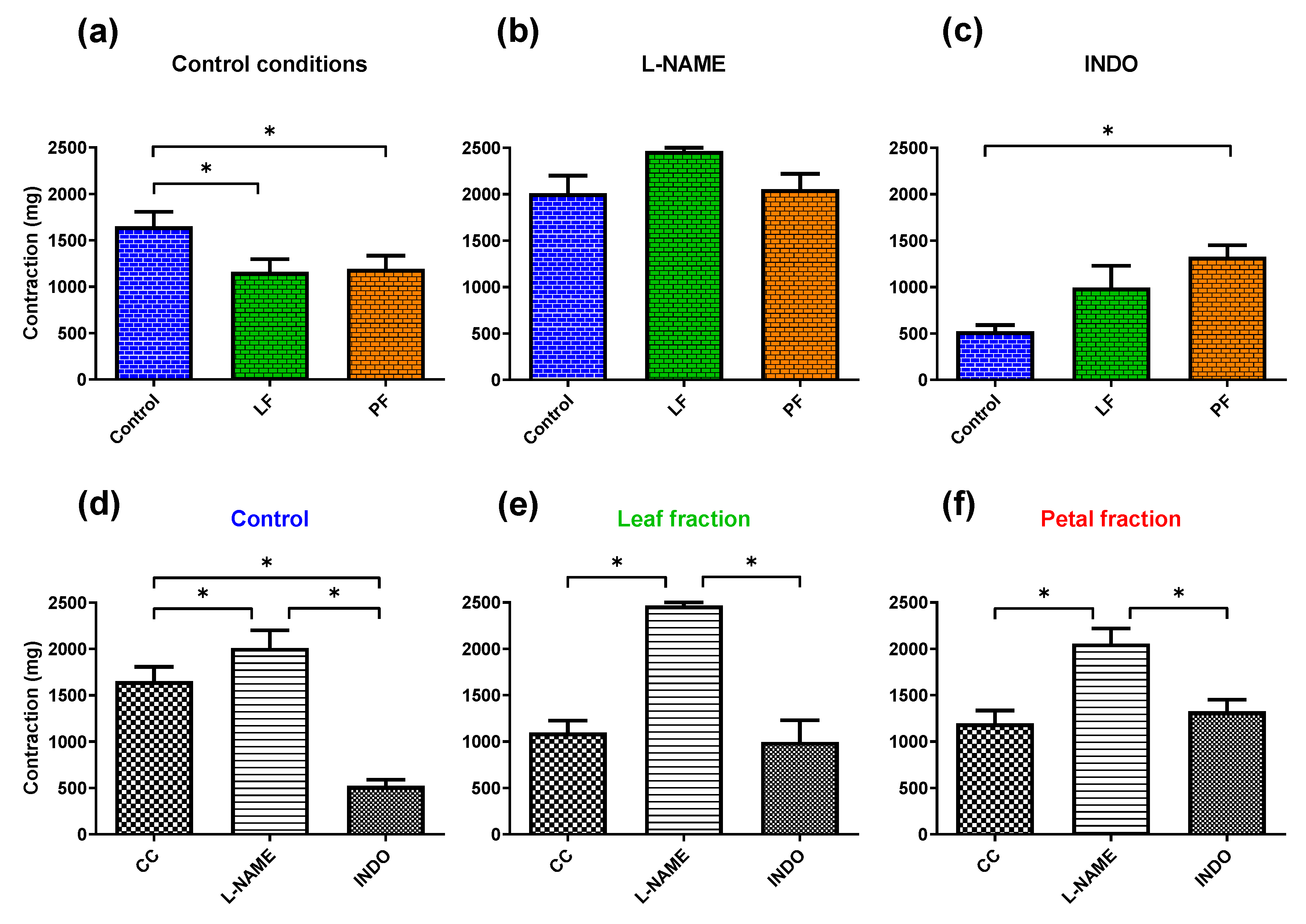
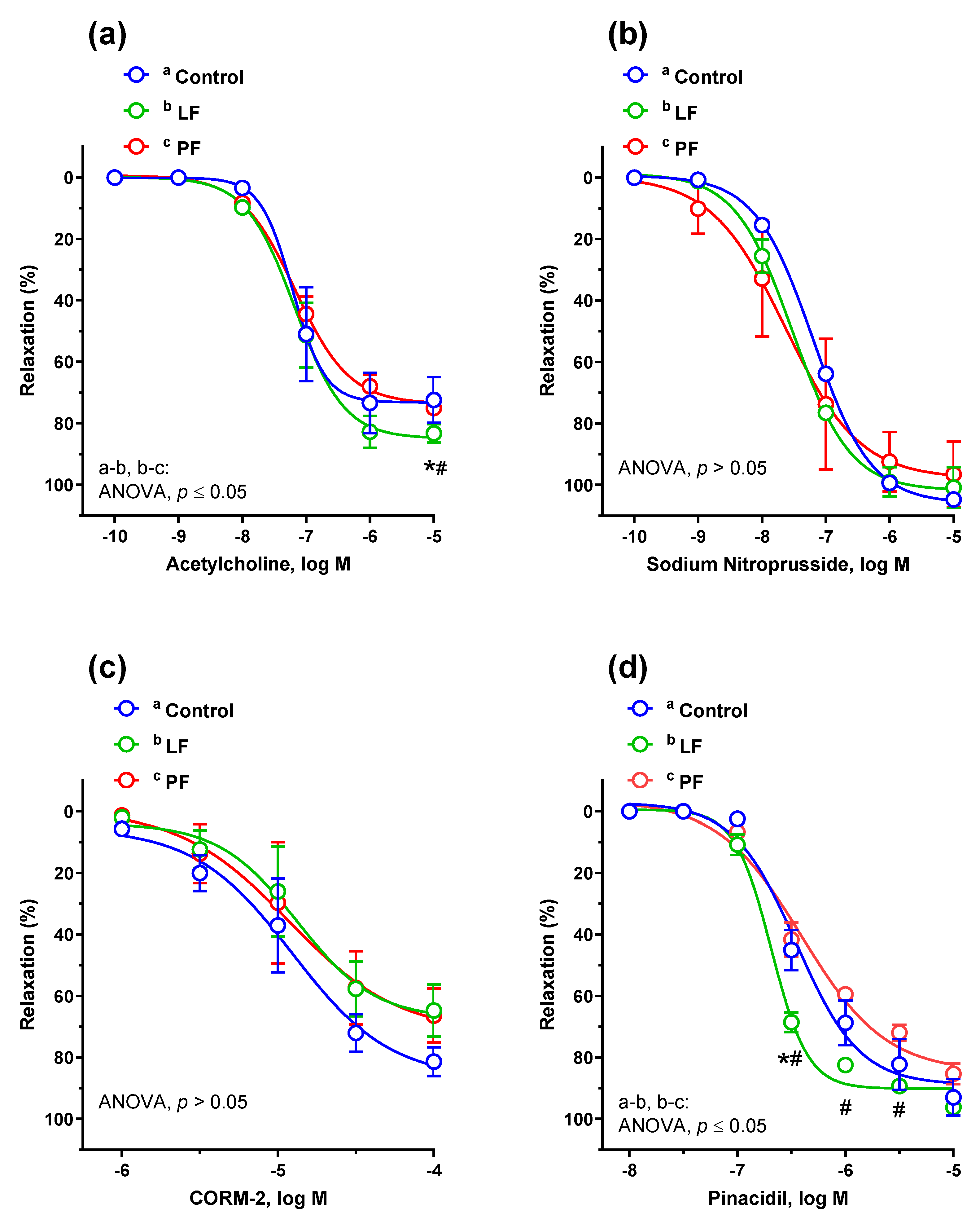
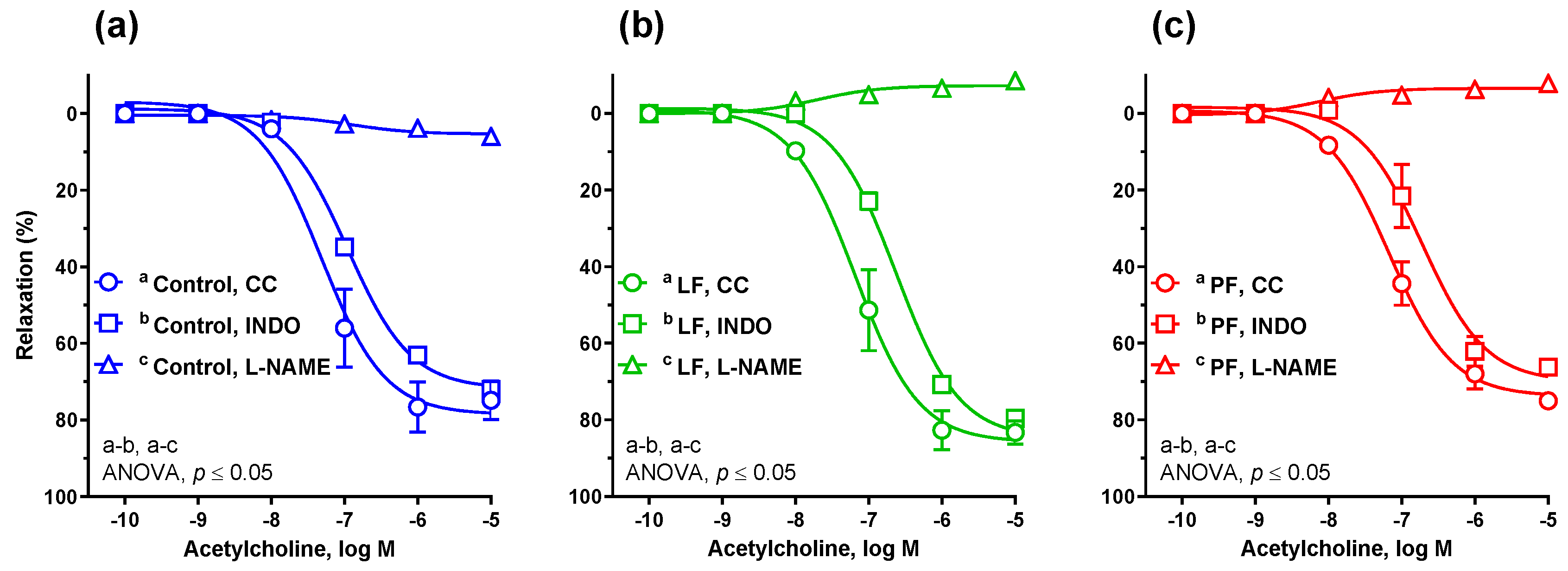
| Drug | Control | Leaf Fraction | Petal Fraction | |||
|---|---|---|---|---|---|---|
| Emax (%) | pEC50 | Emax (%) | pEC50 | Emax (%) | pEC50 | |
| ACh | 73 ± 5 | 7.21 ± 0.19 | 85 ± 4 a,b | 7.18 ± 0.10 | 74 ± 3 | 7.17 ± 0.08 |
| +Indomethacin | 71 ± 3 | 6.97 ± 0.07 | 80 ± 6 | 6.70 ± 0.04 * | 70 ± 8 | 6.83 ± 0.17 |
| +l-NAME | - | - | - | - | - | - |
| SNP | 98 ± 6 | 7.45 ± 0.18 | 101 ± 2 | 7.52 ± 0.27 | 94 ± 8 | 7.63 ± 0.27 |
| CORM-2 | 87 ± 15 | 4.91 ± 0.18 | 67 ± 13 | 4.88 ± 0.19 | 72 ± 25 | 4.93 ± 0.33 |
| Pinacidil | 90 ± 6 | 6.27 ± 0.30 | 90 ± 2 | 6.72 ± 0.24 a,b | 88 ± 6 | 6.26 ± 0.41 |
© 2020 by the authors. Licensee MDPI, Basel, Switzerland. This article is an open access article distributed under the terms and conditions of the Creative Commons Attribution (CC BY) license (http://creativecommons.org/licenses/by/4.0/).
Share and Cite
Majewski, M.; Lis, B.; Juśkiewicz, J.; Ognik, K.; Borkowska-Sztachańska, M.; Jedrejek, D.; Stochmal, A.; Olas, B. Phenolic Fractions from Dandelion Leaves and Petals as Modulators of the Antioxidant Status and Lipid Profile in an In Vivo Study. Antioxidants 2020, 9, 131. https://doi.org/10.3390/antiox9020131
Majewski M, Lis B, Juśkiewicz J, Ognik K, Borkowska-Sztachańska M, Jedrejek D, Stochmal A, Olas B. Phenolic Fractions from Dandelion Leaves and Petals as Modulators of the Antioxidant Status and Lipid Profile in an In Vivo Study. Antioxidants. 2020; 9(2):131. https://doi.org/10.3390/antiox9020131
Chicago/Turabian StyleMajewski, Michał, Bernadetta Lis, Jerzy Juśkiewicz, Katarzyna Ognik, Małgorzata Borkowska-Sztachańska, Dariusz Jedrejek, Anna Stochmal, and Beata Olas. 2020. "Phenolic Fractions from Dandelion Leaves and Petals as Modulators of the Antioxidant Status and Lipid Profile in an In Vivo Study" Antioxidants 9, no. 2: 131. https://doi.org/10.3390/antiox9020131
APA StyleMajewski, M., Lis, B., Juśkiewicz, J., Ognik, K., Borkowska-Sztachańska, M., Jedrejek, D., Stochmal, A., & Olas, B. (2020). Phenolic Fractions from Dandelion Leaves and Petals as Modulators of the Antioxidant Status and Lipid Profile in an In Vivo Study. Antioxidants, 9(2), 131. https://doi.org/10.3390/antiox9020131






